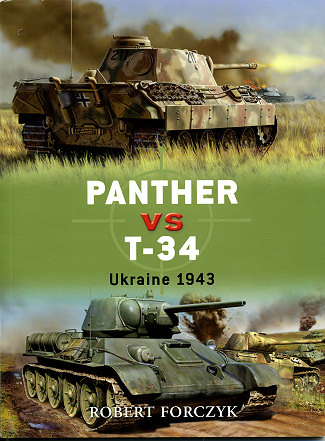 The new
'Duel' series from Osprey is really getting underway, this time with another
tank vs tank book on the German Panther and the Soviet T-34. It concentrates on
the introduction of the Panther and subsequent battles during 1943.
The new
'Duel' series from Osprey is really getting underway, this time with another
tank vs tank book on the German Panther and the Soviet T-34. It concentrates on
the introduction of the Panther and subsequent battles during 1943. |
Title: |
Panther vs T-34: Ukraine 1943 |
|
Author: |
Robert Forczyk |
|
Publisher/Distributor |
Osprey Publishing |
|
Price |
$17.95 MSRP |
|
Reviewer: |
|
| Notes: |
80 pages, 7¼ x 9¼ inches, softcover ISBN: 978-1-84603-149-6 |
 The new
'Duel' series from Osprey is really getting underway, this time with another
tank vs tank book on the German Panther and the Soviet T-34. It concentrates on
the introduction of the Panther and subsequent battles during 1943.
The new
'Duel' series from Osprey is really getting underway, this time with another
tank vs tank book on the German Panther and the Soviet T-34. It concentrates on
the introduction of the Panther and subsequent battles during 1943.
The Panther was designed as a replacement for the PzKfw III and IV medium tanks, who were not doing well against the Soviet T-34s. It was intended to incorporate several of the design features discovered by inspecting captured T-34s into the design of the new German tank. However, the Germans suffered a great deal from political machinations and back-stabbing so the end result was a tank that did not meet the needs of the military. Its main failings were the use of a gasoline engine vice a more fuel efficient diesel, poor placement of the transmission (it was front vice rear drive) and a transmission that was not sturdy enough to handle the increased weight of the tank. Breakdowns were commonplace and more Panthers were destroyed by their own crews than were destroyed by enemy action. Not only that, but unlike the T-34, the Panther was complex to build, with the result that only about 1600 Panthers of all variants were built, compared to nearly 16,000 T-34/76s.
However, the Panther was superior in terms of firepower and armor protection to the T-34/76. Very few Panthers were destroyed by the Soviet T-34/76 while Panthers in the last 6 months of 1943 managed to destroy over 600 T-34s. Still, it was the reliability and numbers of the Soviet tank that helped to turn the tide. The lack of reliability of the Panther more than overcame its technical superiority, a story that was repeated time and again in the German armaments industry.
In line with other books in this series, the author takes us through the design and development of the two combatants, the strategic situation at the time, technical specs and a more detailed look at systems. Then it is on to several specific combat scenarios that showed how each side used their tanks. This is followed by a section on statistics and analysis which leads to what was learned and follow-up vehicles.
In all, it is a superb look at these two tanks and how well they operated in combat against each other. A book that I can highly recommend for you.
November 2007
For more on the complete line of Osprey books, visit www.ospreypublishing.com. In the US, it is Osprey Direct at 44-02 23rd St, Suite 219, Long Island City, NY 11101., where you can get a catalogue of available books.
If you would like your product reviewed fairly and quickly, please contact me or see other details in the Note to Contributors.